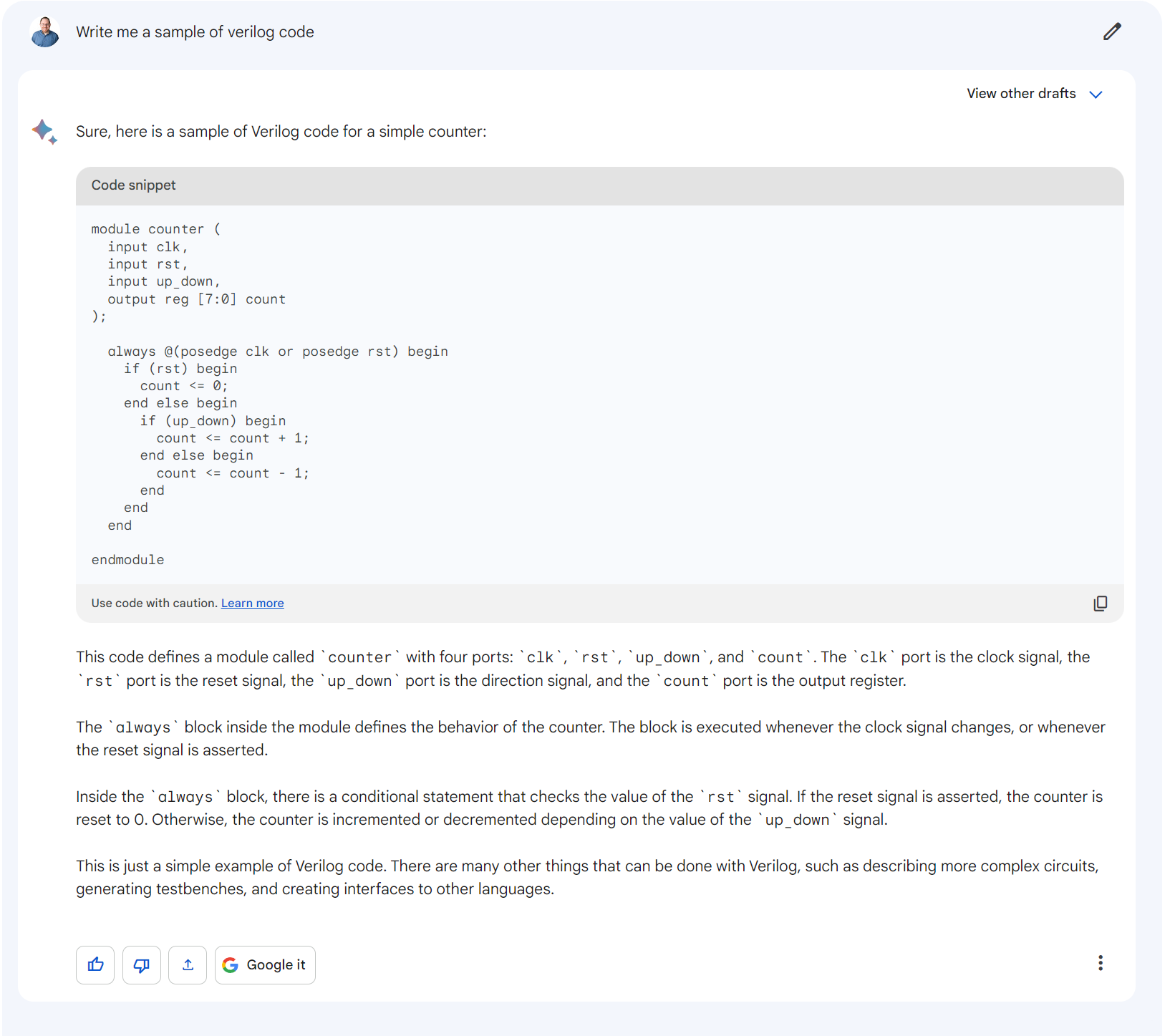Contest Seeks Best AI-Generated Chip Designs

Using AI bots to write business letters or generate detailed 4-second videos is so last week. The next frontier is using AI to help you design custom silicon for your projects. That's why Efabless, a company which makes custom chips to order, is hosting a contest to encourage makers to design their own silicon with the help of AI.
Winners of Efabless's AI-Generated Open Silicon Design Challenge will have their chips fabricated for free, a process that normally costs just under $10,000 for the company's customers. The contest is open now, with entries needed by June 2nd.
How exactly would one use AI to design a chip? Believe it or not ChatGPT and Google Bard are capable of writing Verilog code on command. Verilog an HDL (hardware description language) which can be used in the chip fabrication process as it spells out key details about the digital circuits and registers.
When I asked Bard to write me some sample Verilog code, I got this. I don't know enough about Verilog to say whether it's good code or not.

Efabless hosts a platform for creating and getting sample sets of open-source chips designed and fabricated. The company has several shuttles a year where customers can have their designs shipped to a fab and returned a few months later. The company's chipIgnite program allows you to use a RISC-V core, an automated design flow and get your choice of 100, 300 or 1,000 engineering samples.
After fabrication is complete, you get packaged dies and some of your parts will be put on evaluation boards you can use for testing. You can then use the company's open-source tools to test your design and flash firmware to it. The company charges $9,750 per chipIgnite project.
If you want to get started trying to make your own chip design, you can sign up for a free account at Efabless and check out the company's many resources and tutorials. This walk-through video seems particularly helpful.
Get Tom's Hardware's best news and in-depth reviews, straight to your inbox.
You can also see many of the open-source designs that folks have made with Efabless, on its projects page. These include a VGA sprite generator, a 10-bit DAC with analog neural network and crypto mining SoC.
In order to be eligible for the AI-Generated Open Silicon Challenge, entrants must have at least the Verilog for their chip generated by an AI and must include all of the prompts or auto GPT session logs in the submission. You can, however, do your verification outside of the AI environment. The designs must be open source so anyone can reproduce them and must be implemented using the OpenLane chipIgnite flow.
Entries will be judged by a panel of experts with winners announced on June 9, 2023. It's not immediately clear from the rules how many winners there will be. All of the rules and instructions for entry are on the contest's page.
Avram Piltch is Managing Editor: Special Projects. When he's not playing with the latest gadgets at work or putting on VR helmets at trade shows, you'll find him rooting his phone, taking apart his PC, or coding plugins. With his technical knowledge and passion for testing, Avram developed many real-world benchmarks, including our laptop battery test.
-
PlaneInTheSky So this AI company needs as many people as possible to design a chip for "AI". AI, that according to Nvidia, is supposedly replacing humans in chip design. Interesting.Reply -
gg83 I think this is how China will get around patents on US technology. Just have AI develop a new design and architecture for chips and stuffReply -
gg83 Reply
An ai within an ai where people do something that nobody knows.PlaneInTheSky said:So this AI company needs as many people as possible to design a chip for "AI". AI, that according to Nvidia, is supposedly replacing humans in chip design. Interesting. -
Vanderlindemedia ReplyPlaneInTheSky said:So this AI company needs as many people as possible to design a chip for "AI". AI, that according to Nvidia, is supposedly replacing humans in chip design. Interesting.
Designing a chip takes years - and often a team of 150 highly skilled devs.
If a team of 10 can use AI to design a more efficient or faster chip, it's a win win.
I'm sure AI can benefit greatly to the design of CPU's / GPU's and have it quite more efficient to what we have today. And most camps are using AI to design portions of the GPU. -
helper800 Reply
The problem with this approach is that it takes 1500 highly educated, very niche, AI specialists consulting with 150 highly skilled devs to create an AI that has a shot in the dark at completely designing a useful chip architecture.Vanderlindemedia said:Designing a chip takes years - and often a team of 150 highly skilled devs.
If a team of 10 can use AI to design a more efficient or faster chip, it's a win win.
I'm sure AI can benefit greatly to the design of CPU's / GPU's and have it quite more efficient to what we have today. And most camps are using AI to design portions of the GPU. -
A Stoner How would you know if the AI was not pulling a China on you and putting in backdoors that it can use later to help it take over the world?Reply -
A Stoner Reply
But when they are done, that AI can create infinitely more chip designs and will continue to improve over time far into the future...helper800 said:The problem with this approach is that it takes 1500 highly educated, very niche, AI specialists consulting with 150 highly skilled devs to create an AI that has a shot in the dark at completely designing a useful chip architecture.
